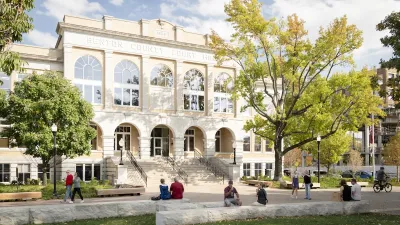Before moving to New York, I'd viewed street design through a fairly simple lens: narrow streets good, wide streets bad. By and large, I still hold this view. But after living here for a few months, I have learned that not all wide streets are equally bad. The wide roads of the South are generally terrible, but New York has made some of its wide streets a bit more pedestrian-friendly. To see why, go to Google Street View and examine three addresses: 5019 U.S. 23 in Chamblee, Georgia, 770 Eastern Parkway in Brooklyn's Crown Heights neighborhood, and 107-43 Queens Boulevard in my current Queens neighborhood of Forest Hills.
Before moving to New York, I'd viewed street design through a fairly simple lens: narrow streets good, wide streets bad. By and large, I still hold this view. But after living here for a few months, I have learned that not all wide streets are equally bad. The wide roads of the South are generally terrible, but New York has made some of its wide streets a bit more pedestrian-friendly. To see why, go to Google Street View and examine three addresses: 5019 U.S. 23 in Chamblee, Georgia, 770 Eastern Parkway in Brooklyn's Crown Heights neighborhood, and 107-43 Queens Boulevard in my current Queens neighborhood of Forest Hills.
First look at the Chamblee address. You will see a road that is seven or so lanes wide. There is no median, so the pedestrian has to cross seven lanes at once, obviously a death-defying act. Not surprisingly, pedestrian fatalities and injuries are fairly common on this road (known to everyone but Street View as "Buford Highway"). Other suburban Atlanta streets have medians that are so thin as to be barely usable: for example, if you go to Cobb Parkway and Galleria Parkway in Smyrna, you will see six lanes of traffic, then a median that appears to be about a foot or two wide, then four more lanes of traffic. Would you feel safe standing on that median?
Now go to the Queens Boulevard address. This street appears to be about twelve lanes. But having lived here for a few months, I can say with some certainty that it is less scary to cross. Why? Because every three or four lanes there is a median. So a pedestrian can walk across three lanes of one-way traffic to median A, then to median B, then finally to the other side of the street. Moreover, a couple of the outer lanes are taken up by on-street parking, which means that the pedestrian often has to cross only one or two lanes of speeding traffic at a time rather than three. Because each chunk of the trip is not so long, the street is not as intimidating as the Atlanta-area addresses discussed above.
Finally, go to the Eastern Parkway address. The street itself is twelve lanes wide: three lanes, then six lanes in the middle, and three lanes. But the northern and southern sets of lanes again have on-street parking, thus reducing the amount of car traffic that the pedestrian must contend with. And when the pedestrian crosses the first three lanes, he or she reaches not a tiny concrete median but a "pedestrian mall" (really a median wider than most sidewalks) which is lined with greenery and street trees. After the six-lane main stretch of Eastern Parkway, the pedestrian reaches another pedestrian mall. Thus, our pedestrian not only does not have to cross all twelve lanes at once, but gets to walk in an fairly appealing environment if he or she just wants to be on Eastern Parkway rather than being on both ends of that street. (On the other hand, Eastern Parkway's six-lane middle stretch might be scarier than any one part of Queens Boulevard).
In sum, both Eastern Parkway and Queens Boulevard are far more pedestrian-friendly than Buford Highway, despite being significantly wider. Why? Because both streets use on-street parking to reduce the number of lanes a pedestrian must cross, and use medians and greenery to ensure that pedestrians don't have to cross as many lanes at a time as on Buford Highway. In addition, Eastern Parkway uses its "pedestrian mall" to decorate the street and make it feel more welcoming than the concrete jungle of Queens Boulevard.

Americans May Be Stuck — But Why?
Americans are moving a lot less than they once did, and that is a problem. While Yoni Applebaum, in his highly-publicized article Stuck, gets the reasons badly wrong, it's still important to ask: why are we moving so much less than before?

Using Old Oil and Gas Wells for Green Energy Storage
Penn State researchers have found that repurposing abandoned oil and gas wells for geothermal-assisted compressed-air energy storage can boost efficiency, reduce environmental risks, and support clean energy and job transitions.

Placekeeping: Setting a New Precedent for City Planners
How a preservation-based approach to redevelopment and urban design can prevent displacement and honor legacy communities.

San Francisco’s Muni Ridership Grew in 2024
The system saw its highest ridership since before the Covid-19 pandemic, but faces a severe budget shortage in the coming year.

Colorado Lawmakers Move to Protect BRT Funding
In the face of potential federal funding cuts, CDOT leaders reasserted their commitment to planned bus rapid transit projects.

Safe Streets Funding in Jeopardy
The Trump administration is specifically targeting bike infrastructure and other road safety projects in its funding cuts.
Urban Design for Planners 1: Software Tools
This six-course series explores essential urban design concepts using open source software and equips planners with the tools they need to participate fully in the urban design process.
Planning for Universal Design
Learn the tools for implementing Universal Design in planning regulations.
Heyer Gruel & Associates PA
City of Moreno Valley
Institute for Housing and Urban Development Studies (IHS)
City of Grandview
Harvard GSD Executive Education
Salt Lake City
NYU Wagner Graduate School of Public Service
City of Cambridge, Maryland






























